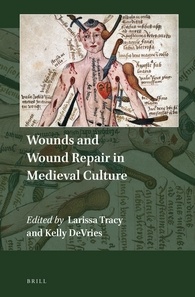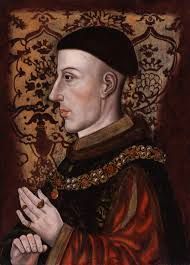Medieval surgeons surprisingly skilled in healing horrific wounds, says book by Longwood professor
|
FIRST PRINTED BY LONGWOOD.EDU At the Battle of Shrewsbury in 1403, future King Henry V was shot in the face with an arrow that lodged six inches deep into the back of his skull. A surgeon saved his life. Skilled medical care in a period often associated with wanton violence? Indeed, says a medieval scholar who recently published a book on the subject.
"Wound repair was fairly sophisticated in the medieval period. Most people assume that it was not sophisticated, but it was," said Tracy. "For example, they used maggots to debride necrotized skin and used honey as an antibacterial to prevent infection. They knew they needed to clean wounds, even if they didn’t know why. "We know from 12th-century surgical manuals that they knew how to treat skull fractures. There is no way to know if they had anesthesia, but they understood opium and herbs, so I imagine they figured it out," said Tracy, adding that forensic archaeologists have determined from studying disinterred remains that "a lot of wounds healed." Honey was used to treat the dire wound sustained by Henry V, then a 16-year-old prince, which is detailed in one of the book’s chapters by Michael Livingston. Honey was used both while removing the arrowhead (accomplished with probes "infused with rose honey," wrote royal surgeon John Bradmore), as well as in closing and healing the wound, a painstaking process repeated by Bradmore over 20 days. While skeletal remains often reveal evidence of wound treatment, they can also indicate the cause of death and postmortem mutilation. The remains of the notorious King Richard III, slain in the 1485 Battle of Bosworth, which ended the War of the Roses and placed the Tudors on the throne, shows that his corpse was stabbed repeatedly. One of the book’s contributors, Robert Woosnam-Savage, was a member of the team of investigators that examined Richard’s remains after they were uncovered in a parking lot in Leicester, England, in 2012.  Wounds and Wound Repair in Medieval Culture Wounds and Wound Repair in Medieval Culture"We know that Richard died from a number of blows to the head with sharp-bladed weapons, which is called sharp force trauma, and he also suffered sharp force trauma after death," said Tracy. "Scholars suggest his corpse was thrown over a horse, and, in a case of postmortem mutilation, soldiers stabbed it and whacked at it." Richard’s skeleton bears traces of at least 11 wounds, "probably nine at the time of his death and two after his death," wrote Woosnam-Savage, a weapons curator at the Royal Armouries Museum in Leeds, England. "The massive trauma to Richard’s skull indicates that he was probably both helmetless and lying prone, facedown." In addition to co-editing the book, Tracy contributed one of the chapters. That chapter, related to her interest in the Arthurian legend, analyzes head wounds in the Stanzaic Morte Arthur, an anonymous poem written in Middle English in about 1400, as a political warning about the destabilizing effects of rebellion and weak kingship. The book features 23 contributors from a variety of fields, including archaeologists, art historians, historians, literary historians, theologians, linguists and medical experts. It was co-edited by Dr. Kelly DeVries, a professor of history at Loyola University Maryland who is an expert on medieval warfare. "The book was Kelly’s idea, which he’d been thinking about for years, and he invited me to be co-editor," said Tracy, adding that it’s the first installment in a series she edits called Explorations in Medieval Culture from the publisher Brill. "The series will be interdisciplinary and will feature both monographs and collected volumes." Tracy co-founded and co-directs Longwood’s Undergraduate Medieval Conference, Meeting in the Middle. She received the 2015 Scholarly Achievement Award from the Southeastern Medieval Association in October 2015. Excerpt from Wounds and Wound Repair in Medieval Culture: "Many modern misconceptions about the Middles Ages suggest that medieval society was medically stunted, backwards, or primitive, and that treatments bordered on the ludicrous or downright dangerous. But numerous surgical texts circulated throughout medieval Europe and some offered more useful (and successful) treatments than others. Medieval surgery evolved from a complex system of text, practice, belief, transmission, science, and folklore. The first major medical center was twelfth-century Salerno, Sicily, where Christian and Muslim communities lived side by side. Many medieval medical and surgical texts and treatments reflect Muslim influence and, in some cases, origins."
The Scar of Henry VMatthew Lewis blog
On 21st July 1403, a rebel army led by Sir Henry Percy, known as Harry Hotspur, son of the 1st Earl of Northumberland, gave battle to the forces of King Henry IV. The somewhat beleaguered monarch was supported by his oldest son and heir, Henry of Monmouth, Prince of Wales, who was only 16 years of age. This young man was later to become the legendary king of Agincourt fame, “Hammer of the Gauls” as his tomb inscription lauds him. That sunny day was darkened by clouds of arrows and rang with the screams of the many dying. It may also have defined the future Henry V as we remember him. The background to the Percy rebellion was a mounting list of grievances that they felt was going unaddressed. They had been loyal to the new regime initially, but went unpaid for their ongoing defence of the troublesome and perilous Scottish border. Harry Hotspur, a famed soldier in his early forties, was dissatisfied that his wife’s brother, Edmund Mortimer, Earl of March was being left to languish as a prisoner of the Welsh rebel leader Owain Glyndwr, his ransom unpaid. Harry and his uncle, Thomas Percy, Earl of Worcester marched south to offer battle to the king on the Welsh border. The two armies met on 21st July at Shrewsbury in fierce fighting that Holinshed recounts lasted three hours. During one of the many volleys of missiles, Prince Henry was hit in the face by an arrow which embedded itself six inches into his right cheek, probably at a downward angle as the arrow fell. Raphael Holinshed, the Tudor chronicler, recounted that:
When the battle was finally over, the Percy force fleeing after Harry Hotspur fell, Prince Henry was rushed to receive treatment. The arrow shaft was removed, but the barbed head was lodged, unreachable and immovable. Eventually, the London surgeon John Bradmore was called to see what he could do. Bradmore’s answer was as revolutionary as it was risky. He later wrote a book entitled Philomena, in which he retold the treatment that he devised;
Bradmore worked away at widening the wound to give himself room to reach the arrow head. Once he could access it, he screwed the thread of his newly invented implement into the arrow head. Next, he tells how “Then by moving it to and fro (with the help of God) I extracted the arrowhead”. The next concern was how to treat the gaping wound in the Prince of Wales’ cheek and prevent a deadly infection from taking hold.
Bradmore describes this wound as being on Henry’s cheek, “next to his nose on the left side”, though it is generally believed that it was the prince’s right cheek that was hit; Bradmore perhaps referring to his own left. The surgeon’s star was in the ascendant. He was paid 40s for medicines provided to the king’s household in 1403 and granted an annuity of ten marks for his successful treatment of the prince. Later, he was made Searcher of the Port of London in 1408. He was also called upon to treat one William Wyncelowe, the king’s pavilioner, whose suicide attempt left him with a wound to his stomach. Bradmore treated him for eighty days and the man survived. He wrote his book, Philomena, before his death in 1412. The wound left a physical scar on Henry that he carried for the rest of his life. The only remaining contemporary portrait shows him in profile, his left side facing the viewer. It is likely that this was to avoid displaying his damaged right cheek. For all of his fame as the victor of Agincourt and for forcing himself to be recognised as the rightful heir to the throne of France, this early episode and the physical mark that it left upon the prince is often overlooked. Henry’s apparent desire to hide it may suggest that it was not a mark of battle that he wore with pride. Perhaps he did not want his enemies to be made aware of his mortality and the fact that a stray arrow almost killed him at 16. He needed to appear invincible if he was to inspire fear in the French. It might also be worth considering the psychological impact of this near-death experience on the young Prince of Wales. It is well known that Henry was something of a tearaway in his youth. Honlinshed reports that when he became king, Henry had a sudden, severe change of attitude; “For whereas aforetime he had made himselfe a companion unto misrulie mates of dissolute order and life, he now banished them all from his presence (but not unrewarded, or else unpreferred) inhibiting them upon a great paine, not once to approch, lodge, or sorourne within ten miles of his court or presence”. It is possible that his experience at Shrewsbury caused him to go off the rails for a while, the brush with death causing him to embrace a life of fun and excess whilst his position afforded him that luxury. By 1407, he was key to his father’s efforts in Wales, so must have curtailed his wild living. Once king, it had to end. The early trauma may have also informed his more sober role as king. Henry was a renowned soldier, but piety and honour forged a strong moral compass (the execution of prisoners at Agincourt is often cited against this, but it can be understood in its context, if not excused because the threatened French resurgence did not materialise). Henry offered the King of France a single combat duel between himself and the French king’s son, The Dauphin (the king being too infirm for such a trial). It is most likely that Henry did so knowing not only that the Dauphin lacked military experience and courage and so would be forced to decline, dishonouring himself, but also that in the unlikely event of acceptance, Henry would win. However, he told the French king Charles VI that he wished to settle the matter in this manner to avoid “the effusion of blood”. Agincourt was to be the only pitched battle of Henry’s French campaign and he perhaps genuinely wished to avoid them where possible, preferring not to spill the blood of thousands of men. Henry was also famous during his campaign for his treatment of his men, from whatever social level. He would apparently walk the camp frequently, not only keeping his men on their toes, but conversing with them, offering praise where it was due, criticism when it was warranted and encouragement where it was needed. This approach may have been nurtured by his experience at Shrewsbury. He had learned at a young age that any man present might be the one that would save his life. He should therefore be grateful that each one is there and instil in every man the desire to save their good and gracious king. Shrewsbury may, after some reflection, have created and reinforced his believe that God was on his side. All of this may be to overstate the impact of the injury Henry sustained at Shrewsbury, but it is compelling to see the horrific injury as sending him off the rails as he realised how narrowly he had escaped death, and to see it at work in his later treatment of his men and his behaviour on campaign. If nothing else, it explains why we see him only in profile on his left hand side. Here is a video discussing the removal of the arrow head from Prince Henry’s cheek: I shall leave you with Holinshed’s Chronicle’s assessment of Henry at the end of its detailing of his reign:
Matthew Lewis is the author of a brief biography of Richard III, A Glimpse of King Richard III along with a brief overview of the Wars of the Roses, A Glimpse of the Wars of the Roses. Matt’s has two novels available too; Loyalty, the story of King Richard III’s life, and Honour, which follows Francis, Lord Lovell in the aftermath of Bosworth. The Richard III Podcast and the Wars of the Roses Podcast can be subscribed to via iTunes or on YouTube. Matt can also be found on Twitter @mattlewisauthor. |
[premium_newsticker id="211406"]




